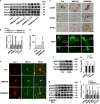Extrasynaptic NMDA receptor-induced tau overexpression mediates neuronal death through suppressing survival signaling ERK phosphorylation
- PMID: 27809304
- PMCID: PMC5260900
- DOI: 10.1038/cddis.2016.329
Extrasynaptic NMDA receptor-induced tau overexpression mediates neuronal death through suppressing survival signaling ERK phosphorylation
Abstract
Intracellular accumulation of the hyperphosphorylated tau is a pathological hallmark in the brain of Alzheimer disease. Activation of extrasynaptic NMDA receptors (E-NMDARs) induces excitatory toxicity that is involved in Alzheimer's neurodegeneration. However, the intrinsic link between E-NMDARs and the tau-induced neuronal damage remains elusive. In the present study, we showed in cultured primary cortical neurons that activation of E-NMDA receptors but not synaptic NMDA receptors dramatically increased tau mRNA and protein levels, with a simultaneous neuronal degeneration and decreased neuronal survival. Memantine, a selective antagonist of E-NMDARs, reversed E-NMDARs-induced tau overexpression. Activation of E-NMDARs in wild-type mouse brains resulted in neuron loss in hippocampus, whereas tau deletion in neuronal cultures and in the mouse brains rescued the E-NMDARs-induced neuronal death and degeneration. The E-NMDARs-induced tau overexpression was correlated with a reduced ERK phosphorylation, whereas the increased MEK activity, decreased binding and activity of ERK phosphatase to ERK, and increased ERK phosphorylation were observed in tau knockout mice. On the contrary, addition of tau proteins promoted ERK dephosphorylation in vitro. Taking together, these results indicate that tau overexpression mediates the excitatory toxicity induced by E-NMDAR activation through inhibiting ERK phosphorylation.
Figures





Similar articles
-
NMDA receptor mediates tau-induced neurotoxicity by calpain and ERK/MAPK activation.Proc Natl Acad Sci U S A. 2006 Feb 21;103(8):2892-7. doi: 10.1073/pnas.0511065103. Epub 2006 Feb 13. Proc Natl Acad Sci U S A. 2006. PMID: 16477009 Free PMC article.
-
Opposing role of synaptic and extrasynaptic NMDA receptors in regulation of the extracellular signal-regulated kinases (ERK) activity in cultured rat hippocampal neurons.J Physiol. 2006 May 1;572(Pt 3):789-98. doi: 10.1113/jphysiol.2006.105510. J Physiol. 2006. PMID: 16513670 Free PMC article.
-
NMDA receptor subunit composition determines beta-amyloid-induced neurodegeneration and synaptic loss.Cell Death Dis. 2013 Apr 25;4(4):e608. doi: 10.1038/cddis.2013.129. Cell Death Dis. 2013. PMID: 23618906 Free PMC article.
-
Mechanism of Oxidative Stress and Synapse Dysfunction in the Pathogenesis of Alzheimer's Disease: Understanding the Therapeutics Strategies.Mol Neurobiol. 2016 Jan;53(1):648-661. doi: 10.1007/s12035-014-9053-6. Epub 2014 Dec 17. Mol Neurobiol. 2016. PMID: 25511446 Free PMC article. Review.
-
NMDA receptor activity determines neuronal fate: location or number?Rev Neurosci. 2015;26(1):39-47. doi: 10.1515/revneuro-2014-0053. Rev Neurosci. 2015. PMID: 25324444 Review.
Cited by
-
N-methyl-D-aspartate receptor blockade reduces plasticity-related tau expression and phosphorylation of tau at Ser416 residue but not Thr231 residue.Exp Brain Res. 2021 May;239(5):1627-1637. doi: 10.1007/s00221-021-06090-z. Epub 2021 Mar 25. Exp Brain Res. 2021. PMID: 33768378
-
Alzheimer's Disease and Impaired Bone Microarchitecture, Regeneration and Potential Genetic Links.Life (Basel). 2023 Jan 29;13(2):373. doi: 10.3390/life13020373. Life (Basel). 2023. PMID: 36836731 Free PMC article. Review.
-
Alzheimer's Disease and Protein Kinases.Adv Exp Med Biol. 2021;1275:285-321. doi: 10.1007/978-3-030-49844-3_11. Adv Exp Med Biol. 2021. PMID: 33539020
-
Building a Bridge Between NMDAR-Mediated Excitotoxicity and Mitochondrial Dysfunction in Chronic and Acute Diseases.Cell Mol Neurobiol. 2021 Oct;41(7):1413-1430. doi: 10.1007/s10571-020-00924-0. Epub 2020 Jul 22. Cell Mol Neurobiol. 2021. PMID: 32700093 Free PMC article. Review.
-
Activation of the ERK/Creb/Bcl‑2 pathway protects periodontal ligament stem cells against hydrogen peroxide‑induced oxidative stress.Mol Med Rep. 2019 May;19(5):3649-3657. doi: 10.3892/mmr.2019.10027. Epub 2019 Mar 14. Mol Med Rep. 2019. PMID: 30896883 Free PMC article.
References
-
- Khatoon S, Grundke-Iqbal I, Iqbal K. Levels of normal and abnormally phosphorylated tau in different cellular and regional compartments of Alzheimer disease and control brains. FEBS Lett 1994; 351: 80–84. - PubMed
-
- Khatoon S, Grundke-Iqbal I, Iqbal K. Brain levels of microtubule-associated protein tau are elevated in Alzheimer's disease: a radioimmuno-slot-blot assay for nanograms of the protein. J Neurochem 1992; 59: 750–753. - PubMed
-
- Yasojima K, McGeer EG, McGeer PL. Tangled areas of Alzheimer brain have upregulated levels of exon 10 containing tau mRNA. Brain Res 1999; 831: 301–305. - PubMed
-
- Obulesu M, Venu R, Somashekhar R. Tau mediated neurodegeneration: an insight into Alzheimer's disease pathology. Neurochem Res 2011; 36: 1329–1335. - PubMed
Publication types
MeSH terms
Substances
LinkOut - more resources
Full Text Sources
Other Literature Sources
Molecular Biology Databases
Miscellaneous

